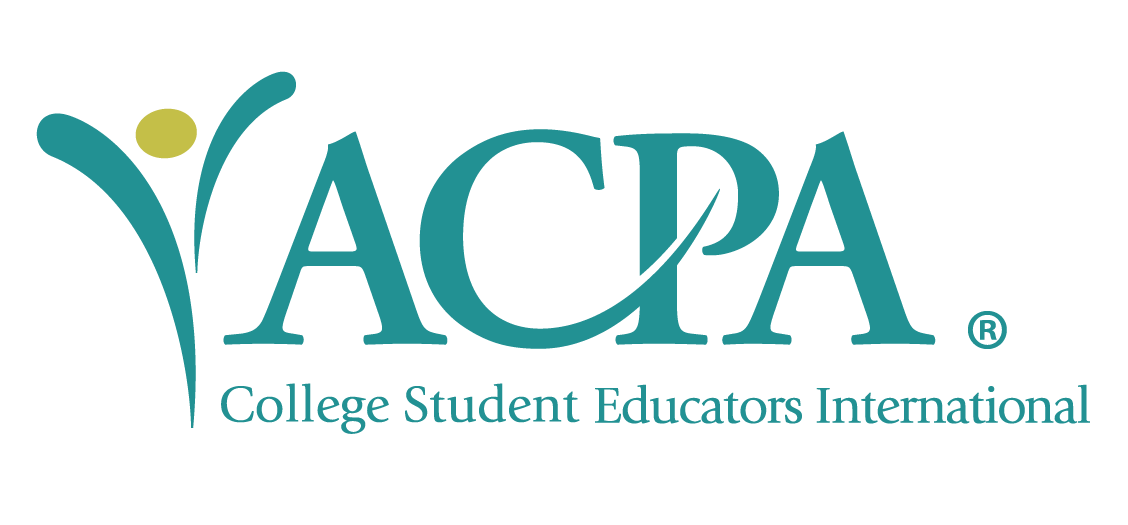By Leslie Jo Shelton
Chair, Commission for Professional Preparation
Background
I currently serve as the ACPA Commission for Professional Preparation (CPP) Chair. In this role, I got to meet other entity leaders at the St. Louis Convention where we formed connections and brainstormed together (and ate good food!). One of these conversations with Brittany Stanton, Commission for Student Involvement (CSI) Chair, led to the idea for a brief piece on what current higher education/student affairs (HESA) graduate students are learning in graduate preparation programs and how this might differ from what was taught ten years ago. She noted that HESA educators may find this information useful as they supervise current graduate students. Many of the HESA curricular updates I highlight below reflect my own interests and experiences as a HESA master’s student, practitioner supervising HESA master’s students, doctoral teaching apprentice for HESA master’s students, and HESA faculty member. Although not a fully formal or comprehensive examination, the following thoughts and resources offer highlights of the current state of learning in HESA graduate preparation programs and curricular developments from the last decade.
Professional Association Guidance
As a HESA faculty member, many of my curricular updates are shaped by knowledge coming from our professional associations, such as our umbrella organizations of ACPA and NASPA. For example, the ACPA/NASPA Competencies document aims to “set out the scope and content of professional competencies required of student affairs educators in order for them to succeed within the current higher educational environment as well as projected future environments” (2015, p. 7). The 2015 competencies are: Personal and Ethical Foundations; Values, Philosophy, and History; Assessment, Evaluation, and Research; Law, Policy, and Governance; Organizational and Human Resources; Leadership; Social Justice and Inclusion; Student Learning and Development; Technology; Advising and Supporting. The current competencies document has some updates from the original 2010 version, as scholars renamed two competency areas, introduced one new competency area, and combined two areas. What follows is a summary of the most significant changes (For a more detailed examination of the development of professional competencies throughout HESA history, including a discussion on Council for the Advancement of Standards in Higher Education (CAS), see Ardoin et al., 2019).
- Shifting from “Equity, Diversity, and Inclusion” to “Social Justice and Inclusion” to indicate a movement away from mere awareness to a more active orientation and process
- Adding Technology as a competency versus a “thread” running through other competencies, and with a focus on application to holistic student development
- Updating “Advising and Helping” to “Advising and Supporting” to emphasize relational and facilitative roles of HESA educators in centering college student agency in their self-authorship development
- Altering the language of “knowledge, skills, and attitudes” to “knowledge, skills, and dispositions” to better mirror related scholarship and to reflect dispositions as attitudes, values, and beliefs
- Moving from “threads” to “intersections” that indicate the points of emphasis running through all competencies: globalism, sustainability, and collaboration
- The three levels within each competency moved from “basic, intermediate, and advanced” to “foundational, intermediate, and advanced,” which reflects the sophisticated and reasonable level expected of entry level professionals who can build on this foundation
These competencies can provide guidance throughout HESA graduate programs, ranging from curricular planning to supporting students in creating professional development plans. The competencies have also been viewed through a critical lens regarding colonization as our profession looks inward, which highlights another key area of recent HESA curriculum.
Centering Social Identities within a Matrix of Power, Privilege, and Oppression
Given that “[t]he development of student affairs was interwoven with the racism, sexism, and homophobia that existed within American society” (Hevel, 2016, p. 859), HESA graduate programs have had the opportunity and responsibility to grapple with this reality while preparing students to thoughtfully navigate current and future climates. One example of this increasing emphasis on social identities is reflected in the current Student Development in College: Theory, Research, and Practice text (Patton et al., 2016). This commonly used textbook was restructured in the most recent edition to reflect scholarship centering social identity and foundational knowledge regarding privilege, oppression, multiple identities, and intersectionality (For more on interrogating the assumptions underlying earlier theories through a critical lens, see Abes et al., 2019). This social identity is apparent in the third edition organization which forefronts social identity theories and leaves first and second wave theories for the last half of the book, which means the text is “more likely to engage diverse students whose background may relate to one of more of these theories” (p. xxi) to help students engage early in rich, critical analysis of theories. These social identities range from updated scholarship on racial, ethnic, sexual, gender and gender identity, faith and spirituality identity, disability identities and identity development, and social class and identity development, as well as emerging theoretical perspectives including digital, national, feminist, student veteran, and student athlete identities (For more information, see College Students in the United States: Characteristics, Experiences, and Outcomes – 2nd ed. By Renn & Reason, 2021).
In addition to scholarship evolving to meet the needs of our student demographics and their related experiences, curricular updates have also centered using a critical lens to inform practice. For example, in “A Bold Vision Forward: A Framework for the Strategic Imperative for Racial Justice and Decolonization” (SIRJD) (Quaye et al., 2019), HESA scholars address how the field is not insulated from the “realities of inequity and injustice, particularly targeting Indigenous and racially minoritized peoples in the U.S. and globally…” (p. 6). The key elements of the Strategic Imperative framework are noted below, and allow educators to tap into the potential of our agency and self-awareness to create positive change:
-
- The core is Love: Humanization, radical democracy, critical consciousness
- Guiding principles: Questioning the knowledges we use; emphasizing agency; developing authentic relationships; watching out for each other; centering compassion and healing; suspending efficiency and embracing dialogue; an always becoming; responsibility rather than compliance; educating through problem-posing
- All of the above is couched within a circle that includes understanding historical dynamics
Integrating the SIRJD in HESA curriculum allows us to ask critical questions such as: “What possibilities lie ahead if we know each other as human? What future can we imagine together? How much more do we all gain by engaging our interconnected pursuit of racial justice and decolonization?” (2019, p. 20). The scholarship noted above may guide HESA curriculum to varying degrees in different programs and settings, but these concepts are guiding conversations in professional associations and in practice.
Current Conversations
Current HESA conversations often revolve around the challenges and opportunities of working in this field and how to best prepare graduate students for these complex roles. Recent conversations have centered the visibility of the “great resignation” from the field during the COVID-19 pandemic “as increased pressure and failure to support campus frontline workers have taken a toll” (ACPA, 2022, p. 4). A recent ACPA Report on 21st Century Employment in Higher Education (2022) document focused on “fostering great recruitment and retainment…a call to action to build sustainable careers in higher education by dismantling systems of supremacy culture in our work” (p. 7). These efforts are necessary, a lack of equitable pay and benefits was compounded by…the expectation of “self-sacrifice, overworking, and obliging unrealistic demands” in HESA throughout “multiple crises facing our campuses (e.g., COVID, white nationalism, attrition)” (p. 23). However, Renn and Reason (2021) noted, “we do not know what the pandemic, the economic crash, and eventual recovery will mean for higher education in the coming years” (2021, p. 3). Formal scholarship will address these concerns, and in the meantime, these conversations are taking place “on the ground” with current HESA graduate students and professionals, including in classrooms, workplaces, professional associations, and on social media.
These are topics that can be explored with HESA graduate students in a supportive environment as we engage in lifelong learning together. Some additional suggestions I have tried including building time into one-on-one meetings with graduate assistants to ask what they are learning in the classroom and how they are thinking about this related to their work, exploring course syllabi with students to learn about updated resources and topics, and inviting graduate assistants to facilitate a staff development session based on classroom learning as it applies to practice. Overall, I find HESA students are eager to share their connected learning experiences in the classroom and in practice, and the ever-evolving curriculum in response to student and overall HESA needs provides a dynamic and exciting learning environment to engage in together.
References
ACPA-College Student Educators International. (2022). Presidential task force on 21st century employment in higher education [Report]. https://developments.myacpa.org/message-from-the-acpa-president-december-2022/
ACPA-College Student Educators International. (2022, December 13). Commission for Professional Preparation. https://myacpa.org/groups/cpp/
ACPA-College Student Educators International, & NASPA-Student Affairs Administrators in Higher Education. (2015). Professional competency areas for student affairs educators [Report]. https://www.naspa.org/images/uploads/main/ACPA_NASPA_Professional_Competencies_FINAL.pdf
Abes, E. S., Jones, S. R., & Stewart, D-L (Eds.). Rethinking college student development theory using critical frameworks. Stylus Publishing.
Ardoin, S., Crandall, R., & Shinn, J. (2019). Senior student affairs officers’ perspectives on professional preparation in higher education and student affairs graduate programs. Journal of Student Affairs Research and Practice, 56(4), 379-393.
Hevel, M. S. (2016). Toward a history of student affairs: A synthesis of research, 1996-2015. Journal of College Student Development, 57(7), 884-862. https://doi.org/10.1353/csd.2016.0082
Patton, L. D., Renn, K. A., Guido, F. M., & Quaye, S. J. (Eds.). (2016). Student development in college: Theory, research, and practice (3rd ed.). Jossey-Bass.
Quaye, S. J., Aho, R. E., Beard Jacob, M., Dominque, A. D., Guido, F. M., Lange, A. C., Squire, A., & Stewart, D-L. (2019). A bold vision forward: A framework for the strategic imperative for racial justice and decolonization [Report]. ACPA-College Student Educators International. https://myacpa.org/wp-content/uploads/2021/09/SIRJD_GuidingDoc2.pdf
Renn, K. A., & Reason, R. D. (Eds.). College students in the United States: Characteristics, experiences, and outcomes (3rd ed.). Stylus Publishing.



Recent Comments